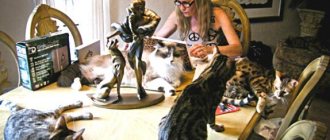A pet brings joy and peace, comfort and a special atmosphere to the house. However, the behavior of the tailed family member is not always a solid “A”. A cat can tear off new wallpaper, ignore its toilet, and bite the legs of household members and guests. Having discovered such dirty tricks, the owner thinks about how to punish the cat in order to correct its behavior.
A disciplined and obedient cat is the dream of many households. It is useful for the owner to know which punishment techniques are acceptable for cats and which are not.
Beating and humiliating a cat is useless and dangerous
Beating and humiliating a cat for educational purposes is the worst thing the owner of a guilty animal can think of. Humiliation and physical violence will not achieve obedience from your pet. He will not be able to grasp the cause-and-effect relationship between his behavior and moral and physical pressure; he will not be able to somehow connect these events.
Beating and humiliating a kitten or an adult cat is also prohibited for another reason. Felines have an extremely vulnerable psyche. Anything can throw them out of emotional balance. Many cats have a hard time traveling in a car, a change of scenery, the appearance of a child or a new four-legged inhabitant in the house, even moving to another room can have a negative impact on their psyche.
Screaming and physical impact on them can lead to severe mental disorders that will require long-term and expensive treatment. However, there is no guarantee that it will be successful.
Tailed bully is not recommended:
- Poking your nose into urine and feces. Poking in its own excrement will result in severe stress for the animal. It will begin to fear its owner, and its behavior will become even more unpredictable, if not inadequate.
- Beat. In the mind of the pet, physical punishment will be fixed not in connection with the action committed, but with the offender or the object with which he was punished, for example, with a slipper. As a result, he will begin to avoid shoes and the person who offended him, but will not stop doing what he was beaten for.
- You can’t stop doing something using the “no” command. These animals do not understand the meaning of this word, and perceive prohibitions as a violation of their personal boundaries.
Beatings and humiliation will not solve the problem. This will only push the pet away, but will not improve the situation. The only thing that can be done without harming the cat’s psyche is to lightly slap it on the back with your palm at the moment the “crime” is committed.
Should you decide to punish your cat?
No matter how pitiful the cat makes, stand your ground
The dictionaries say that punishment is the imposition of retribution, as retribution for an insult or a wrongdoing. This is a negative incentive that leads to unwanted behavior in the direction of the offender in order to eliminate or reduce the occurrence of such behavior.
The main purpose of punishment is to ensure proper behavior . This is a form of discipline that can bring out the best in your cat. Oddly enough, the motivation for punishing your beloved furbaby is love in order to provide him with a better, happier life.
This is interesting: The most unusual cat breeds
How to punish for biting or aggression
Aggressive behavior of a pet is unacceptable - bites from dogs of even small breeds can lead to serious injuries. Due to the structure of the jaws, they easily tear skin and muscles, and the force of teeth clenching is enough to break a human bone. Increased aggressiveness of dogs does not manifest itself sharply; as a rule, this is a consequence of improper maintenance and upbringing, regular physical violence from the owner. The following types of aggression should be distinguished:
- sexual;
- defensive and defensive;
- hierarchical;
- hunting;
- gaming;
- interspecific;
- maternal.
In addition, the dog may begin to bite due to exposure to sharp external stimuli. If she bites the owner or one of the family members, the reaction in the form of punishment should be immediate. You need to immediately take the pet by the collar and give a severe reprimand
Wait for a stable state, and to switch attention, you can do some unexpected action
After the first demonstration of aggression towards people, it is recommended to go to OKD courses, as well as adjust the education process so that the pet understands the hierarchy. If there have been attempts to attack other animals on the street, walks should only be carried out with a muzzle. Biting and growling should not be punished physically, which can make the situation worse. After the dog has accepted the punishment and goes to reconciliation, it is imperative to show a good attitude towards it.
How to wean a cat in adulthood
Owners of adult pets also face an unpleasant surprise. If a cat trained to use a litter box begins to relieve itself outside of the litter box, there are several reasons for this. The following situations may be the reasons for such behavior in an adult animal:
- A dirty tray that has not been washed well or the dirty litter has not been removed.
- Changing the location of the tray.
- The litter box has become small and does not correspond to the size of the grown cat.
- Replacing the filler.
How to stop a cat from pooping in the wrong place in these cases? It is necessary to return the usual filler, rinse the tray more often with warm water, and when moving it, place the toilet as close as possible to the place where it stood previously. If the cat puts marks for other reasons, then the owner will have to start processing these places. A popular method is to spray it with Antigadin spray; on the contrary, treat the tray with a special composition for training cats or put an additional container with filler.
How to stop a cat from shitting on the bed
A pet can make a mess anywhere; the owner can only immediately begin to solve the problem. It is especially not recommended to hesitate in a situation where a kitten is pooping on the bed. Your pet will develop the habit that the bed is a comfortable place to relieve itself. This problem also applies to adult animals, and experienced owners give the following advice on how to stop a cat from shitting on the bed:
- close the doors to the bedroom tightly so that the animal cannot get inside;
- treat the headboard with lavender oil;
- the pet experiences a lack of communication or jealousy, so it is necessary to pamper the cat more often, play, and pet it;
- not allowed to sleep on the bed next to the owner;
- Castration helps to discourage adult animals from pooping on the bed, sofa and other surfaces.
In flowers
For outdoor felines, burying excrement in the ground is the norm. Some pets are also susceptible to this instinct, so a kitten may start shitting in flowers, or less often an old pet. The following measures will help solve the problem of how to stop an adult cat from shitting in the wrong place:
- remove flower pots from the balcony or inaccessible places where the cat cannot get into;
- purchase mineral filler;
- cut the lemon peel or chop the garlic, placing them directly in the pot;
- Line the window sill with foil or double-sided tape.
On the beds
For furry predators, this is their own “hunting” territory that should be protected. In this way, the animal leaves peculiar marks for other brothers, declaring its rights. How to stop a cat from marking territory in open space? First you will have to find the reason, and the most common ones are an anxious state or the threat of invasion of other animals into its territory. The following recommendations will help correct the situation:
- Sprinkle the edges of flower beds and small beds with ground red pepper.
- Leave food because cats are clean creatures and will not go to the toilet near food.
- Lay out a plastic net for plants.
- Plant catnip and valerian away from the beds.
- Place rosehip, hawthorn or spruce branches along the beds.
At the entrance
A terrible smell in a confined space often occurs because a pet is allowed outside. How to stop a cat from shitting in a public place? Among the available remedies is to wash with acetic acid or bleach, then spread out the lemon slices. Effective products from the pet store - "Nature's Miracle", "Urine-Off" or others, which should be applied directly to the treated area.
What is the problem
As you know, in the urban conditions of multi-story buildings, walking cats on the street is an impossible task, and therefore they carry out all the “small and big things” in special trays installed in a certain place in the apartment. If the animal defecates carefully and only in a tray, then maintaining sanitary conditions is not so difficult, and the smell can be easily eliminated.
To stop a cat from crapping, you need to identify and eliminate the reasons for this behavior.
The problem arises when an adult cat, for some reason, does not want to “go” to the litter box or suddenly changes its habits and stops doing it. A favorite place in this case can be a sofa, bed, carpet, flower pot or just the floor. Naturally, a “fragrance” appears throughout the apartment, yellow stains, and constant puddles. A reasonable question arises: how to wean a cat from shitting anywhere and teach it to use the designated place.
The first thing you need to understand is that a cat, by its nature, is a fairly clean animal, which means that there are good reasons for its inappropriate behavior. The question of how to stop cats from pooping in inappropriate places at home can only be resolved positively if the cause of this behavior is identified and eliminated. Initially, you should understand the essence of the problem: the cat previously only went to the litter box or is this due to shortcomings in raising the kitten; the cat shits in certain places or does it throughout the apartment; Has the overall character of the animal and its habits changed?
It is also important to understand what has changed dramatically in the apartment or family
Various painful sensations can cause an animal to shit anywhere
Methods of punishment for mischief
There are different ways to punish a cat for mischief. For example, when a cat tries to climb onto the table or steal food from it, you can prohibit the animal from doing this in a stern voice with a moderately elevated tone. If during the prank your eyes meet with the cat, he can easily read dissatisfaction on your face. To enhance the effect, you need to threaten him with your finger without sudden movements and loudly say “no!”
The fear technique also works on animals. To punish, you should not wave your hand at him; it is better to choose available means. This could be a towel, a spray bottle with a stream sent at the cat, a banal clap of your hands, or the creation of other noise. A cat will really not like it if you click it on the nose after doing something nasty and punish it with this.
Correcting bad behavior
Since cats have developed logic, their behavioral reflexes can be adjusted not only with a stick, but also with a carrot:
- Encouragement. A gentle voice, soft stroking, and the use of words with a large number of hissing consonants have a calming effect on the pet.
- Treat. Effective method. It cannot be used on an ongoing basis, as it quickly becomes established as a food reflex.
Affection and attention are the best helpers in the fight against inappropriate pet behavior
Your pet's behavior can be changed by understanding the animal's motivation. If you see the reasons that provoke a cat to actions that are absurd from a human point of view, there is a high probability of eliminating the irritating factor.
Video - How to train a cat
"Crimes" and punishments
One can only adapt to the habits of semi-domesticated “dwarf lions”. The main principle of education is not to suppress, but to satisfy the needs of a willful animal. Otherwise, the cute kitten will turn into a secretive and vengeful beast. Let's consider the typical offenses of meowing pets and competent methods of “re-education”.
How to punish a cat if she shits
An animal must be toilet trained from the first day it arrives in the house. It’s better to buy two trays: cats prefer to go to different places when they need to be small and big. Every time after eating, it is recommended to take the kitten to the toilet and reward it for correct behavior.
A serious mistake is using newspaper as a filler. It is not able to absorb moisture, and the cat’s wet paws will carry specific odors throughout the house. This will inevitably lead to hygienic disorientation of the animal and conflicts with the owners.
How to properly punish a cat in this case? The usual method - “poking with the snout” - will only add to the problems. The pet will understand it in its own way: “That’s right, continue to act this way.” If you add “spanking” to “poking,” fear and resentment will settle in the cat’s soul. Productive ways to solve the “toilet” problem are obvious: changing the filler and/or moving the tray to a place that is comfortable for the cat.
In relation to an adult mischief maker, it is recommended to use different tactics. You should start from understanding the reason for what is happening. When fauna children mark territory, they are claiming leadership. Therefore, the cat must be made to understand: the dominant role in the house belongs to the person.
It is important to catch the miscreant at the “scene of the crime”, lift him by the scruff of the neck and look intently into his eyes (according to the cat’s rules: whoever doesn’t look away wins). It is advisable to reinforce the psychic attack with a threatening hiss and imitation of a cat's finger strikes on the muzzle of the mustache. Then the owner of the animal must “interrupt” the cat’s marks with human ones: wash the puddle and wipe the floor with his own sweaty T-shirt or drink his favorite toilet water
Then the owner of the animal must “interrupt” the cat’s marks with human ones: wash the puddle and wipe the floor with his own sweaty T-shirt or splash his favorite toilet water.
How to punish a cat for aggression
The unfriendly attitude of the meowing companion will be “told” by the ears pressed to the head, the fluffy or nervously tossing tail.
We list common reasons for cat aggression and ways to eliminate them:
Malaise. The cat may be bothered by tooth or joint pain, stomach upset, or nausea. Medical attention is definitely required here. Emotional deviations. Premature weaning from its mother and siblings results in the kitten’s inability to self-control. You should not separate your baby from the family until he reaches the age of 2-2.5 months. Fear of human hands. The phobia is inherent in street “foundlings” and kittens not accustomed to affection. Adaptation of the “savage” will require time, patience and tact. Defending the right to personal space. Cats quickly get tired of games and cannot stand intrusiveness and noise. They should have “their own corner” - a secluded and safe area (under a chair, on a windowsill, in a playhouse) where they can hide, retire, and relax. Manifestation of the hunter's instinct. The natural state of a predator is to overtake and attack fleeing prey. To avoid thinking about how to punish a cat for scratching, you should not use your own hands and feet as teaser toys. The animal must clearly understand: the human body is not a scratching post. If the cat is used to grabbing legs or arms, you should not fuel his excitement with screams and lamentations. Punishing a predator for its hunting instinct is nonsense
You should switch the animal's attention to inanimate objects: balls, laces, ribbons with a tied bow. At first, to avoid scratches, you will have to trim your nails regularly.
Longing for the “bride/groom”
It is not punishment that will help extinguish a cat’s sexual behavior, but a civilized solution - castration or sterilization. Jealousy of the cubs. You shouldn’t hold a “watch” or pick up newborns if the mother cat is against it. Over time, she will warm up and share her squeaking “treasure” with her owner.
By nature, cats are capricious and curious creatures. They give the impression of gentle creatures, but behind their sweet appearance they hide complex, introverted creatures. Often, owners are faced with unpredictable behavior of their pets, which must be corrected in a timely manner. Read on to learn how to punish a cat and what reasons motivate animals to do harmful things.
How to punish a cat?
Should you always scold your cat for bad actions?
It is quite difficult for a person to read the emotions of a mustachioed friend, because the fluffy one is not capable of showing strong feelings. Before punishing a cat for bad behavior, you need to find out the motive for its behavior - what if it is not punishment that is needed, but help?
What habits need correction?
Usually, any prank of a mustachioed friend can be explained. Some habits of a pet can be corrected and may disappear from the mischief-maker’s arsenal over time. So, if a cat persistently climbs onto the table in search of treats, then underfeeding becomes a likely motive.
Sometimes the animal ignores the litter box due to excessive soiling or problems with urination. In this case, it is enough to simply change the filler or consult a veterinarian for advice.
Misdemeanors caused by lack of attention or loneliness (damage to furniture, wallpaper, piles in the wrong place) can be corrected. You need to devote more time to the animal, play with it and caress it - or get a pet partner so that both of them do not get bored when people are away.
What cannot be punished for
You cannot scold an animal that has just appeared in the house. A new family member needs some time to get used to the smells and surroundings of another home. The stress of changing housing, living conditions and new people causes serious emotional stress in the furry. If during this period he is subjected to harsh educational manipulations, the baby is unlikely to understand what they want from him and will withdraw into himself.
Sometimes a four-legged friend marks everything around due to problems with the genitourinary system. Pain while going to the toilet forces you to do wrong things - this should not be confused with harmfulness.
Other ailments can also lead to behavioral deviations. You can’t scold an animal for them - it already feels bad, and it most likely understands that it’s breaking the rules. There's just nothing he can do about it. An attentive owner should monitor the health of his mustachioed friend and consult a doctor in a timely manner.
If not punishment, then what?
Accolades and awards
- Nothing affects a cat like the right treat.
- You don't praise your cat for bad behavior, only for good behavior. For example: the cat used the scratching post - great, you pet it, play with it with a laser, guide the cat towards the scratching post, give it extra fun.
- The cat jumped onto a shelf specially prepared for her, her favorite position by the window - pet her and together you can have fun barking at the birds outside the window.
Expert advice
- When your cat climbs onto the kitchen table, you hiss or make a sound near her so that she associates this unpleasant sound with jumping on the table.
- To discourage your cat from scratching furniture and sofa upholstery, you should cover them with film or foil - cats really do not like such surfaces and will avoid them. At the same time, you need to provide your cat with an alternative - a scratching post designed for her, tailored to her size and preferences. Test out the fancy cardboard scratching posts - their texture is very attractive to cat feet, most cats already know what these cardboard boxes are after a few days. These cardboard pieces are easy to make yourself or you can buy them inexpensively. When the cat tears them, you throw them in the waste paper and make a new one. Cheap, convenient, environmentally friendly.
- A cat urinates on socks thrown anywhere - hide the laundry in a closed basket, keep order. The cat urinates on the bedding - put it in the closet and cover the top of the bed with film or foil - cats don’t really like this surface.
Don't provoke the cat
- A large, wide pot of soil placed on the floor will likely be viewed by the cat as an additional litter box. To prevent this from happening, place the pot on a platform and cover the surface of the ground with pebbles or mesh - it will no longer be attractive to the cat.
- Don't want your cat ruining your clothes? Then put it in a closed closet and leave the laundry basket with the lid closed (installed on top).
- The cat likes to observe its surroundings from a certain height. If you don't want it to be a table, create a viewing area for your cat that is more attractive than a table top and that is easily accessible at all times. Wall shelves are ideal for this role.
Never mind
When your cat is up to something, you can just get up and walk away. Go to the next room, to the kitchen, to the balcony, to leave the house. Leaving the cat to its own devices and temporarily ignoring it when it scratches and bites us is an excellent educational method.
Don't look at or talk to the cat
- Making eye contact and talking to your pet are communication channels that strengthen the bond between human and cat.
- If you temporarily ignore the cat, you will not look at him, you will not talk to him - this will be a punishment for the cat.
Conclusion
Remember one thing - if you are thinking about how to punish a cat? Don't punish me in any way! Use other, more effective and painless methods. Give rewards and positive incentives exactly when the cat is up to something. Don't delay punishment because your cat probably won't associate it with a reason. Good luck!
Solving health problems
Let's say that before your cat always willingly used the tray and litter, and there have been no changes in her life recently.
What then? It is best to take your pet to a doctor. Cats very often communicate their pain to us in this way. Get tested, check your internal organs using an ultrasound. Sometimes urination on upholstered furniture is a consequence of urolithiasis: it hurts the cat to urinate, and he looks for a softer place, in the hope that this will ease his suffering. But only timely treatment can alleviate them, so do not waste time raising the cat, but run to the veterinary clinic.
Another possible reason for bowel movements everywhere is helminthic infestation. Do not neglect regular preventive administration of anthelmintic drugs!
When it is necessary
Before deciding to punish, consider whether you are honest with your pet
If you are still ripe for punishment, you need to clearly define when it will be carried out. The decision depends on the circumstances and whether you are doing what is right for your pet. It is forbidden to “raise” a cat if you do not fulfill the following conditions well:
- Providing sufficient food;
- Providing warmth and comfort;
- Caring for cleanliness and health, timely visits to the veterinarian;
- Confidence that the cat is safe;
- Showing love and providing toys so that the cat can play and sharpen its claws enough.
If at least one point is not fully finalized, the cat simply asks for help. But if you do everything correctly, then move on to choosing the so-called punishment. First of all, remember that a cat is not a person, and he needs special ways to prove that he is doing wrong .
What aerosols are best to use for repelling?
When folk remedies don’t help and the owners are completely desperate, aerosols and special chemicals can come to the rescue that can scare away both an adult cat that is shitting and a kitten that cannot remember the location of the potty.
There are two main types of sprays which are:
- scare away cats;
- attract cats.
You can choose your own litter box training tactics. It all depends on whether you want to attract the cat with a smell to the place where he should directly do his business, or whether you want to discourage him from all his “favorite” places and simply leave him no choice.
The cost of such toilet training products is quite reasonable.
When a pet categorically refuses to go to the toilet and at the same time spoils property and things, the owner can often reach a state of despair.
However, you should not rush to conclusions and think that your cat is doing his dirty tricks to spite you. It is quite possible that a specific reason led to this behavior, which must be identified.
Reasons why the cat began to shit anywhere
Animals of any age can start walking past the tray. More often, this habit develops due to the cat’s bad character or poor upbringing. It is also impossible to exclude the possibility that the cat began to urinate anywhere due to illness. To objectively assess the situation, the owner needs to monitor the pet.
Unsuitable tray
Cats stop going to the litter box for the following reasons:
- Inappropriate location. To prevent the animal from urinating in an inappropriate place, it is advisable to install the tray so that it is hidden from prying eyes, since cats love privacy. If the animal becomes distracted and nervous when visiting the toilet, there is a possibility that instead of the tray it will choose another place, for example, a rug or sofa.
- Wrong pot size. Trying to place the tray compactly, many owners buy a container that is too small for the pet, in which it is inconvenient for them to fit.
- The cat may pee past the litter box if it is dirty or has a strong smell of cleaning products.
- The animal does not like the litter used (or lack thereof).
- The owner does not clean the potty on time. Cats are real clean people. If the animal went into the tray and it was not removed, the pet will not use it a second time.
- Recent move. If the owner and the pet moved into another apartment, it is likely that the pet did not have time to get used to the new place.
- Development of diseases and infection with worms. Often a cat walks past the litter tray due to pathologies of the urinary system. This is due to the fact that during bowel movements the pet feels discomfort and pain and tries to avoid going to the toilet. If the animal refuses to go to the toilet and the owner notices the presence of questionable symptoms (lethargy, apathy, refusal to eat), it is recommended to show the cat to a veterinarian.
- A cat can defend and mark its territory (this happens especially often if a second pet appears in the house).
- Manifestation of protest. Cats are vulnerable and sensitive animals. If the owner is constantly absent, does not pay enough attention to the pet, or has recently scolded him for something, the cat may show his resentment in this way. In this case, you cannot scold your pet, as the situation will only get worse.
It is quite difficult to identify the reason for this behavior of an animal. But if you don’t find out what was the original source, weaning your pet from a bad habit will be problematic. That is why the owner needs to be patient and constantly monitor the actions and behavior of the pet.
How to stop a puppy from littering the house
Little puppies learn and experience the world like children, and the owner’s task is to teach the pet good manners from the first day it arrives in the house. Puppies are in quarantine for the first 3.5 - 4 months of life due to mandatory immunization against viral infections. Accordingly, all this time they are in the apartment and are forced to crap in the house. During isolation, the puppy develops a strong habit of going to the toilet in its den.
There are several secrets that will help stop your puppy from shitting all over the house:
- It is necessary to choose a separate room for the baby’s toilet - it’s good if it is a balcony or a storage room.
- Cover the entire floor surface in the designated room with paper or a diaper.
- Every time after sleeping and eating, take the puppy for natural needs to the space allocated for the toilet.
- Do not let the pet out of this room until the pet has done its business.
- After emptying the intestines and bladder, praise your pet vigorously so that he understands that the owner approves of his actions.
- During the day, carefully monitor the baby, and at the first signs of going to the toilet (sniffing, circling in one place), immediately pick up the dog and carry it to the room for defecation. You cannot grab a puppy when he has already started peeing; until he is 4 months old, he does not fully control this process and cannot stop it. There will be only one result - a frightened pet and a path of urine throughout the apartment.
- Gradually, your four-legged friend will choose one place in the designated room to defecate, then all other diapers and newspapers can be removed.
Puppies under 4 months of age practically cannot tolerate it if access to the diaper room is limited (the door is closed); you must be prepared for a puddle to appear anywhere. Moreover, during this period, the baby may simply not reach the diaper if it is far away. You can’t scold a dog for this, this is a physiological feature of the body, it’s not the pet’s fault.
If there was a “problem” and the dog went in the wrong place, although the owner tried his best and did everything correctly - in no case should you shout at the baby, physically punish or poke your nose into a pile (puddle). This can lead to terrible stress and fear for the owner; as a result, the puppy will crap, but hide it under carpets, pillows, bedspreads, or even eat the object of the owner’s anger. Further, the owner’s fear will negatively affect the building of relationships and subsequent education.
Basic rules for teaching a puppy to pee on the street
Before you begin to accustom your puppy to walking, you need to remember one important condition - a puppy, starting from 5 months, can tolerate going to the toilet for no more hours than he is months old. If your pet is left at home alone for a longer period of time, he should have access to a diaper, otherwise there will be unpleasant surprises on the floor. What you need to do to teach your puppy to go to the toilet outside:
What you need to do to teach your puppy to go to the toilet outside:
Walk after eating and sleeping. Show your approval by defecating in the street. Take water for walks and actively water your pet. Organize active games (physical exercise speeds up metabolism). Praise for sniffing marks (working with the nose triggers the mark reflex). Do not run home immediately after defecation. The duration of the walk should correspond to the dog's activity. For unsure puppies, taking the toilet out of the house is a suitable method.
It often happens that a dog walks along the street for a long time and persistently, but runs home to the toilet, even during long walks. This may be due to the baby's lack of self-confidence. During quarantine, he gets used to certain smells; when he goes outside, the dog is bombarded with a huge amount of scent information. There are several ways out of this situation:
- Walk down the street until the puppy can't stand it anymore.
- Take the diaper out into the yard and walk around it.
- To add self-confidence to your dog while he is in quarantine, carry the baby outside in your arms.
When dealing with a timid dog, it is especially important to show what he is doing right and to minimize negativity in communication. When defecating in the wrong place, ignore it; when defecating on the street, praise it very actively and treat it with treats.
How to properly punish a kitten
Animal psychologists distinguish several types of aggression. Understanding a cat's behavior strategy will help you understand how to properly punish and educate it. There are 3 varieties:
- Defensive. If you want to take away a toy, offer a treat in return.
- Maternal. The kitten, a girl, copies the behavior of an adult cat: creates a “nest” and protects the “offspring.”
- Aggressive. The owner himself often encourages an attack in the game, then the cat asserts itself.
Punishing a cat correctly means stopping in time. As practice shows: first the owner turns a blind eye to the pranks, then in anger he throws or hits the kitten, sometimes damaging the paws and spine.
If you notice incorrect behavior, start training immediately. Otherwise, the “action-punishment” connection is lost, and the kitten begins to fear the owner.
The worst thing for a cat is to fly into the air
You think it's funny to throw and catch a cat. However, his instinct of self-preservation makes him think about danger and at this moment he experiences real stress. If you don't want revenge from the cat, don't throw it up.
A cat’s paw performs various functions: from washing to protection, and it is also placed on another, showing dominance. The cat treats you as an equal, and if you don’t want to be scratched, don’t touch the cat’s paws again.
Neither a dog nor a cat can tell you what scares and irritates them. And your responsibility, as the owner, is to respond promptly and correctly to the signs that your pet gives you. Respect your pet, and he will only make you happy.
Reasons for disobedience in mustaches
Despite the fact that many scientific and behavioral studies have been conducted, people still cannot fully understand the psychological relationship between a pet and a person. Meanwhile, for a comfortable coexistence, it is important to understand the language of your pet and know the reason for his actions. This is easy for some owners, more difficult for others.
Often there are completely reasonable explanations for bad actions. For example, if a furry dog urinates on the carpet, then he is most likely expressing dissatisfaction with the new filler, the arrival of a new family member, or the rearrangement of furniture in the room.
Stealing tasty morsels from the owner's table usually does not contain negativity on the part of the fluffy. This is just a purely physiological desire to eat. Torn furniture upholstery or scratched wallpaper can be a consequence of inattention on the part of a person or family members.
In general, the cause of disobedience can be determined through short-term or long-term observations. No one knows a cat better than the owner - and it is he who sooner or later guesses the reason behind all her actions.
Basic recommendations
In order to wean puppies and adult dogs from going to the toilet in an unspecified place, a different approach must be used.
For puppies
A caring owner can tell by the puppy's behavior that he will soon pee or poop.
For kids, the main recommendations are:
- When an animal begins to fuss strangely, look for a place, or simply rush to the place where it usually goes to the toilet, this means that you urgently need to get ready to go outside.
- Walks should be organized according to a schedule at the same time at least 5 times a day.
- You need to spend a sufficient amount of time outdoors, otherwise your pet will not have time to pee and poop.
- The dog should be active, as exercise speeds up metabolism and stimulates bowel movements.
- You need to take water with you and give it to the puppy more often. This will guarantee that he will pee.
We must remember that every time after waking up, eating or playing actively, the baby must go to the toilet. This time should be used to wean him from writing at home.
For adult dogs
In this matter, patience is very important, since intemperance and aggression on the part of a person can only get in the way. The main recommendations are:
- If training was carried out incorrectly, you need to apply rules identical to the requirements for puppies.
- If an animal tries to demonstrate dominance over its owner through disobedience, it should start with training.
- Sprays for treating surfaces where the dog often goes to the toilet have proven themselves. They are harmless to people and their pets, do not leave stains, but discourage the desire to shit in unidentified places.
Promotion
At the time of weaning, the main motivation for the dog can be praise when it has done everything right.
There can be several methods of encouragement:
- speak good words when addressing your pet, praise him;
- treat with delicacies;
- clearly show your joy.
The owner can determine which method is more suitable for a particular animal by looking closely at the reactions of his pet.
Sometimes for training they successfully use a word that will be a command for the pet to go to the toilet. It is repeated loudly and clearly every time the dog has done everything as needed. After some time, it will become clear to the pet why this word is said.
How to punish correctly
To wean off a bad habit, it is very important to punish the animal correctly. You can’t ignore mistakes, but you shouldn’t be overly zealous with punishments either, since the dog will associate the owner exclusively with negative emotions
In order for your pet to understand that they are dissatisfied, you need to do the following:
make a stern voice, scold the animal; you should take your favorite toy, showing it and explaining, as far as possible, what caused it, and give it back only after the pet has coped and went to the toilet outside; it is important to teach the dog the commands “No!” or “Ugh!” so that he can quickly understand that they are dissatisfied with his actions.
Features of cat behavior
Furry pets have existed alongside humans for more than 9,500 years. The domestication process began in Ancient Egypt and was completed about 200 years ago.
According to one of the many theories, they made friends with people for selfish purposes. Grain barns have always attracted mice, which were the main source of food for cats.
Despite many studies, scientists have not fully figured out the psychology of the relationship between cats and humans.
Regardless of ulterior motives, coexistence with these animals is beneficial for city dwellers. Scientists have proven that cats have a beneficial effect on the physical and emotional state of their owners, and also reduce the risk of stroke, myocardial infarction and other pathologies of the cardiovascular system.
Behavioral reflexes
To ensure that living together with an animal does not cause discomfort to both participants in the process, it is important to learn to understand the language of communication between pets.
Cats are considered good psychologists, excellent at capturing the mood of others.
Reading cats' emotions is difficult. Unlike dogs, they are not so open and are not capable of violent expressions of feelings.
Before punishing an animal, you should study the relationship between habits and provoking motives.
Table 1. How to decipher a cat's behavior?
| Behavior | Explanation |
| Licking hair and face | Demonstrating maternal instinct, the female licks the kitten. An adult pet copies the actions of its mother and thus shows care for its owner. |
| Bites the skin | Kisses. |
| Kneads the body with its paws | In the juvenile period, the baby massaged the mother’s belly with his paws to obtain milk. Subsequently, this gesture became an expression of the highest degree of satisfaction. |
| Brings dead mice | Teaches the owner the principles of hunting. |
| Touches a person's head | Shows his affection. |
| Demonstratively turns away | If a person is static, it means he is not showing signs of aggression. As a result, the cat calms down and loses interest in him. |
| Rubbing against legs | Leaves a smell, recognizing a person as its property. |
| Buries a bowl of food | You either don’t like the food or hide it for future use. |
| Licks after touching | Gets rid of human odor. |
| Throws himself to his feet | He asks the owner to play. |
| Slows down when passing another cat | Tries to avoid conflict over territory ownership. |
| Buries excrement | Masks its scent in order not to be detected by the enemy. |
Cats can imitate children
Sign language
The main devices for communication in furry pets are the tail, ears and “vocal apparatus”. By some signals you can understand the mood of the animal:
- The tail sticks out like a pipe - it is set up for active games.
- The ears are pressed tightly to the head, the tail is twitching - it is in a playful mood and is preparing to attack.
- The claws are extended, the body is pressed to the floor - scared and grouped for attack.
- The back is rounded as much as possible, the mouth is open threateningly - the highest degree of manifestation of fear.
In addition to body language, cats meow in order to convey information to the owner or other animals.
Purring is one of the ways of communication
Unlike dogs, which produce the same bark, furry pets vary the tones and volume levels of the sounds they make. They skillfully use intonation. An observant owner can easily understand a cat's intentions by analyzing its voice.
Table 2. Decoding of some sound signals
| Sound Characteristics | Explanation |
| Fast, clear | "Hello!" |
| Constricted, chest | The pet is offended or complains about a situation that does not suit him. |
| Interrogative | Characteristic for communication between females and kittens. |
| Nadryvny | Signals pain in the body. |
| Growling | Showing dissatisfaction. |
| Yelling | The animal is scared. |
| Loud, shrill | A sound typical of cats fighting. |
| Lulling | "I love you". |
To quickly reach their owner, cats imitate the intonations of a crying newborn
A hungry cat meows, repeating the sounds of a screaming baby. Using a frequency that is alarming to people, cats manipulate their owners in this way. This clever trick forces people to subconsciously pay attention to them.
How to explain to a child why you should not hit an animal
Some children at a certain age exhibit some aggressive behavior towards our little brothers. This in no way indicates that the child is depraved or has a bad character. It’s just that a period of personal development has come in his life. He is trying to prove to himself and others that he has some weight in the world. And this proof is most often expressed in tangibly changing something in him through his actions. Throwing cups and plates off the table quickly gets boring, the little man moves on to animate objects.
Subconsciously, the child chooses for his experiments creatures that are weaker and cannot, in his understanding, respond well. So poor cats come across the path of these brats, forced to endure the domination of a person who has just come out of diapers. Parents are required to take some measures and explain to their child why cats should not be hit. After all, this self-affirmation can turn into a habit and, over time, spread to people. And on the other hand, not every cat will tolerate beating. Even well-deserved ones, let alone just like that.
The best lesson for a child, of course, would be some response from the offended animal. But cats, unfortunately, do not know how to lightly spank. If they scratch or bite, it is with all their might. And here the task of parents is to explain why they should not touch animals, not so much for humane reasons as for fear for the well-being of their own children. Probably not all mothers know that cats aim to scratch specifically in the eye. In their opinion, this is the most vulnerable place.
There are several options to influence a child's behavior. Which one to choose depends on each specific case. For some children, it is enough to explain how painful the cat is, that she is crying and offended. That she might die if she thought the child didn't love her. For three-year-old children, who have not yet experienced our cruel world, this option is very effective. They are compassionate and kind by nature.
If the child is too aggressive and sometimes received punishment for mischief, then in this case there is nothing left but to intimidate with the most suitable argument from the parents’ point of view. If a schoolboy beats animals, then talking here is useless. Most likely, he is simulating the behavioral algorithm adopted in his family. And you can’t do it without a child psychologist.
Man by nature is obliged to be humane towards weaker creatures. And the question of why cats should not be beaten is not even worth raising. One popular wisdom says: anyone can offend the weak, but only the weak can want to offend the weak. And we in our world should not be weak. Otherwise, there will always be someone weaker who will offend us.
10.08.2017
“They say that cats are cowardly, angry and cruel. This is true, and they have many other advantages.” (Missy Dyzik)
“Sometimes you scold a cat, look at it, and you get the unpleasant feeling that it understood everything to the last word. And I remembered..." (Author: Charlotte Gray)
Cats give their owners a lot of joy and humor; they relieve us of stress and make our home more comfortable.
But at the same time, cats often play dirty tricks: they shit in the wrong place, steal food from the table, tear up furniture and wallpaper, break vases and flowers, and sometimes scratch and bite.
At the same time, cats are more difficult to bring to order than dogs, since they are loners by nature, and not pack animals. In principle, a cat does not have the desire to obey the leader of the pack.
How can you not punish?
Of course, you should never hit a cat!
- Firstly, since cats and people are in different weight categories, it is possible to accidentally injure a mustachioed cat.
- Secondly, it is unlikely that pain itself can prompt an animal to deep thoughts on the topic: “How wrong I was”... She is simply in pain.
A cat is not a person, it is not capable of drawing conclusions. He'll just try to stay away from his owner. And if you beat a kitty often, she will either stop responding to punishment altogether or begin to show aggression.
Analyzing the reasons for bad behavior
Therefore, let's first analyze the offense. Why did the scratchy do this? For example, he tears up furniture. Question: does she have a scratching post? Or, a mustachioed friend goes to the toilet anywhere. Question: is her toilet clean, is her tray small and where is it located? Does the cat like it? The next offense that irritates the owners is that the cat climbs on the tables. Or maybe she's just hungry? Or did they put porridge in a bowl and put cutlets on the table? Then theft is very understandable.
How can you punish a cat without assault?
Having understood the reasons for the misconduct, the problem can be eliminated without punishment. But what if the pet simply forgot who’s boss? Then it’s worth reminding him of this. When a cat is playing dirty tricks by looking into your eyes, you can hiss at him. For a cat, this is a sign of threat. Or hit someone nearby with a towel, stomp, or otherwise create a loud sound.
Sprinkle water on him, or go up, grab him by the scruff of the neck and look straight into his eyes. Cats really don't like this. But, after stopping the offense, it is still worth observing the pet. Maybe bad behavior is explained by other, more objective reasons than just bad character.
By the way, some pussies, when they are punished, begin to do dirty tricks precisely because of severe stress, but as soon as you caress them more instead of punishing them, the bad behavior disappears by itself, as if it never happened. Love is the most reliable and time-tested method of education. Before you punish your cat, think: is it really necessary?
How to deal with cat disobedience?
Only humane and effective means are applicable as methods of combating cat leprosy. By combining these characteristics, the owner can easily cope with the pet’s disobedience.
After applying punishment, you can ignore your pet for a while - the cat does not like to go without communication for a long time. It will be useful not to respond to calls to play with her, not to respond to inviting sounds and the desire to lie on your lap. Then the mischievous woman will realize the wrongness of the act and will try not to do it again.
Cats are independent, inquisitive, capricious and vindictive, so punishment for wrongdoing must be used delicately. Incorrectly selected measures lead to the opposite effect. The best thing is to correct the behavior of the mischief maker by understanding the motives of negative behavior and eliminating them.











